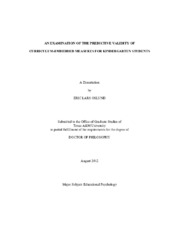| dc.description.abstract | The purpose of the present research was to examine the predictive validity of curriculum-embedded mastery-check measures (CEMs) for kindergarten students in Tier 2 intervention. Two studies examined the predictive validity, parsimony, and changing role of CEMs using a structural equation modeling (SEM) framework. Study 1 examined the ability of CEMs gathered throughout the kindergarten year to predict end-of-kindergarten latent reading outcomes. Study 2 examined the ability of kindergarten CEMs to predict end-of-first and end-of-second grade latent reading outcomes.
Study 1 used SEM with two latent outcomes (i.e., phonemic and decoding) composed of diverse measures of early reading skills gathered at the end of kindergarten. Findings indicated moderate to large effects, as measured by variance explained, for CEMs on predicting phonemic and decoding outcomes. For CEMs gathered at four time points throughout the kindergarten year, a parsimonious set of subtests emerged. In addition, the role of CEMs changed throughout the year as predictors reaching statistical significance were increasingly difficult. Findings indicated that an increased amount of variance could be explained on the outcomes measures as the year progressed.
Study 2 used one latent reading outcome factor gathered at the end of first and second grades. Findings for the end of first grade indicated that parsimonious sets of predictors from CEMs administered at three times during the kindergarten year predicted end-of-first grade outcomes. Additionally, the role of indicators changed during the year and the amount of variance explained increased from the first to third CEM. Results for the end of second grade indicated the variance explained on the outcome measure increased from the first CEM to the third CEM. When considering near-significant results, a pattern emerged demonstrating parsimonious subsets of indicators that changed during the kindergarten year.
Findings from both studies provided support for the predictive validity of CEMs gathered during kindergarten for students in Tier 2 intervention. Results from both studies demonstrated statistically significant subsets of predictors that emerged and changed during the kindergarten year congruent with reading development, which can be useful for informing educational decisions. | en |


